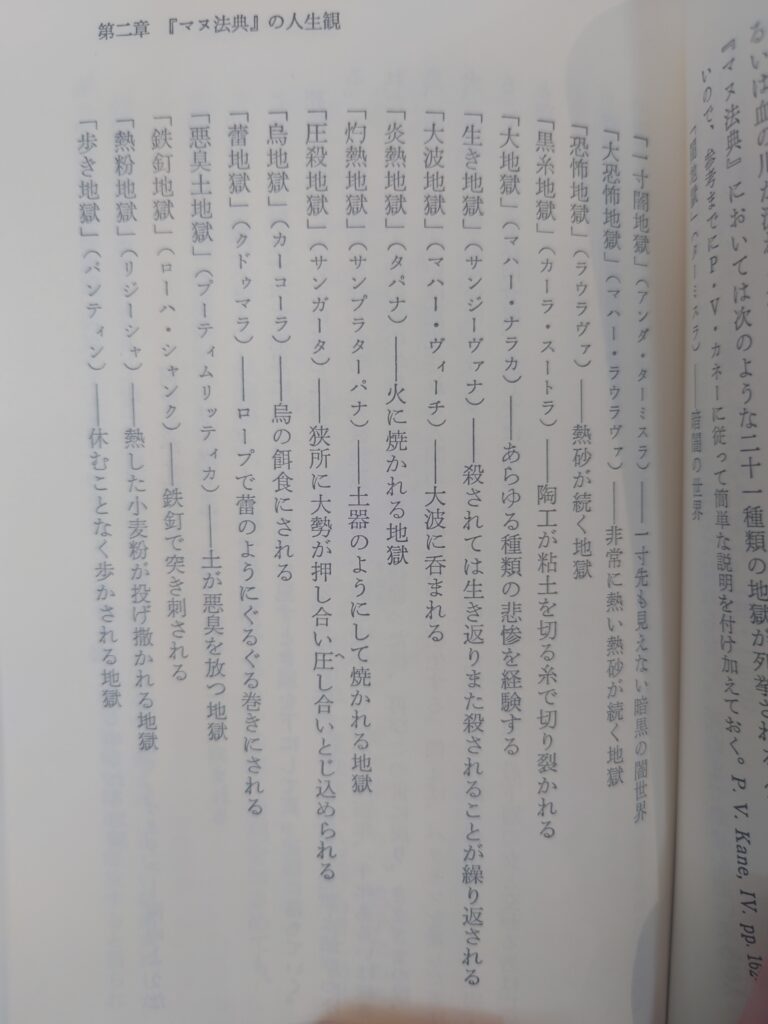Overview and Comments on "The Code of Manu" - The cornerstone of Indian Hindu society. Scriptures expounded on a grand scale from the creation of the world to the laws of human reason.
The book presented here is "Code of Manu" translated by Nobuyuki Watase, published by Heibonsha in 2013.
Let's take a quick look at the book.
The Code of Manu is an ancient Hindu code that explains the laws of society and life from the creation of the world and defines the prototype of Indian society, and is also a supreme treasure of Indian classical literature. A complete translation from the Sanskrit original.
The Code of Manu is a representative Indian classical law established between the 2nd century B.C. and the 2nd century A.D. As a pillar of Hindu doctrine, it forms the basis of the socio-cultural norms of Indian society to this day.
AmazonProducts Page.
The previous article is a commentary on the Code of Manu, by Nobuyuki Watase.The Code of Manu, The Prototype of the Hindu World."introduced.
This commentary is of very high quality and I highly recommend it when reading the "Code of Manu", and now I am finally going to read the "Code of Manu", the main body of the Code.
As mentioned in the book introduction above, the Code of Manu is an Indian sacred text believed to have been compiled between the 2nd century B.C. and 2nd century A.D. This sacred text continues to have a profound influence on Indian society today.
The "Solution" at the end of the volume explains the "Code of Manu" as follows.
This book, The Code of Manu (Mānava-dharmaśāstra or Manu-smṛti), is one of a large body of literature collectively known as the dharmaśāstra.
Around the sixth century B.C., the rise of asceticism shook the orthodox family-centered society that had existed until then, and a reorganization of society was called for. The trump card for social reorganization was the establishment of the four varna (status) system of Brahmanas, Kshatriyas, Vaishyas, and Shudras as the core of society, and the formulation of definite codes of conduct for each of these. This was the beginning of the compilation of the Dharmashastra. The Dharmashastra aimed to define the dharma, or the inherent, holy, and right way of living, for each of the four varnas, and to make it the code of conduct for the orthodox world. From then until the mid-nineteenth century, the Dharmashastra continued to fulfill its mission.
Dharmashastra literally means "teachings on the Dharma. However, since the word "dharma" was translated as "law" in Chinese Buddhist texts, which were then introduced to our country, the Dharmashastra has generally been translated as "code" and, as a result, has been misunderstood as a "law book. While the Dharmashastra is indeed a code of conduct, it is by no means a "law book. The code of conduct in the Dharmashastra is a code of conduct that is much broader than the law, as a reading of the Code of Manu makes clear. It includes rules that belong to the so-called laws, which are subject to punishment and adjudicated by the judiciary, but the essence of the Dharmashastra is to determine in detail how a person should conduct himself throughout his life, from infancy to old age. The legal and judicial equivalent (vyavaharas) are only a part of the Dharmashastra. However, it is also true that in later times, during the time of Dharmanibandha, the judicial part was taken out and the so-called law books were compiled independently. (omitted).
The Code of Manu, the oldest of the second period of the Smriti, was compiled between approximately the second century B.C. and the second century A.D., succeeding the Dharmasutras of the previous period. However, because of the completeness and prestige of its form and content, it has an unshakable place in the history of the Dharmashastra and literally became the sacred text of the Hindu world that followed.
Heibonsha, Nobuyuki Watase's translation of "Code of Manu" p499-500
As will be discussed here, the "Code of Manu" is not a mere law book. The first thing that surprises you when you start reading "The Code of Manu" is that the scripture suddenly begins with the story of creation. It begins with a magnificent cosmology and worldview centering on the Creator, Brahman, and from there, it tells us how we should live and what should be the norms and rules for our lives.
Also, as was taught in the "Code of Manu, the prototype of the Hindu world," the point is not simply to enumerate the norms and systems of life, but to give them a religious authorization by the creator, Brahman.
Furthermore, in "The Code of Manu: A Prototype of the Hindu World," the following commentary on the "Theory of Life" in the Code of Manu was given, which I quote there.
A person's life includes both earthly and afterlife destinies, and it must not be meaningless. The Code of Manu considers that a person's birth must be "an effectual appearance (n. 93)" not only in this world but also in the afterlife. This is expressed in various ways, but the word "fulfillment" (siddhi) is the one that occurs most frequently. Although the word is used without announcing the specifics of fulfillment, it includes both the fulfillment of various aspirations in this world and the attainment of the ultimate state that man must reach after death.
The most frequently appearing aspects of desired fulfillment in this world are longevity, fame, wealth, happiness, and offspring. Here the traditional values and ways of life of the Brahmanical world come to the fore. What emerges is the image of a life of doing the right things, earning a good reputation, accumulating wealth in the right way, being blessed with offspring, and living a long and happy life. To this image of life is added a purpose peculiar to varnas. In the case of the Brahmins, it was mainly the increase in intelligence, in the case of the Kshatriyas, the increase in wealth, and in the case of the Vaisyas, the increase in wealth.
The "Code of Manu" says
Do not despise yourself for previous failures. Pursue happiness until you die. Do not think it unearned. (4.137)
These words can be considered the conclusion of the Code of Manu with regard to life. It was basically a life-affirmation, and had nothing to do with the forest-dwelling, itinerant ascetics who abandoned fame, wealth, or even offspring.
Chuokoron-sha, Nobuyuki Watase, "Manu Code: A prototype of the Hindu world," p. 52-53.
."Do not despise yourself for previous failures. Pursue happiness until you die. Do not think it unearned. (4.137)
These words can be considered the conclusion of the Code of Manu with regard to life. It was fundamentally life-affirming, and had nothing to do with the forest-dwelling, itinerant ascetics who forsook fame, wealth, or even offspring."
This is a critically important part of the "Code of Manu" to consider.
The Code of Manu is a scripture with an aspect of opposition to Buddhism, Jainism, and countless ordained practitioners. While Buddhism was pessimistic and idealized a form of destruction of desires, the Hindu scriptures were world-affirming and did not deny the fulfillment of desires. This may have been the reason why Buddhism died out and Hinduism flourished in India. This is a very interesting point.
The list of hells in the Hindu world is also discussed in the Code of Manu, which was also a surprise.
A clear list was found in the "Code of Manu, Archetype of the Hindu World" and is quoted here.

What do you think? I was astonished when I saw this. The reason I was so struck by this is that the hell in this picture is exactly the same as the Buddhist hell. The Buddhist hell is well known in "Shobonenkyou" and Genshin's "Ojo-Yoshu", but this hell is almost the same as the one described in those books.
I could see that Buddhism also existed in relation to the Hindu world.
In reading the Code of Manu, I strongly feel that Hindu practices and ideas are incorporated into every aspect of life. Furthermore, I found that not only that, but also detailed regulations are set forth in the rites of passage from birth to death. I strongly felt that the Hindu view of the world is carried through from birth to death, and even to the afterlife.
Buddhists in India also lived within this Hindu world. Since Buddhism had a policy of not intervening too much in the daily lives and rituals of its lay followers, their daily lives and rituals were still within the framework of the Hindu world, even though they were Buddhists.
For more information on the circumstances in this area, seeA History of Buddhism in New Asia 02 India II: The Formation and Development of Buddhism.Written by Yasuaki NaraA History of Indian Buddhism as Culture.I was reminded of this after reading the Code of Manu, as has been pointed out in recent studies such as the following. If Hinduism had so firmly shaped people's way of life, it would be difficult to escape from it or ignore it. It is no wonder that Buddhism and Hinduism have become intertwined with each other over time since the time of Buddha's reign.
Furthermore, I felt that we must recognize that Buddhism was born as an outsider in India, where Hinduism (Brahmanism at that time) had been the dominant worldview since the time of the Buddha. When we monks think about Buddhism, we tend to take the viewpoint from the Buddhist side. However, India is not so simple. It is complicated. It is necessary to reconsider the fact that the mainstream of India was, and still is, Hinduism. (Though there was a period of Islamic rule.)
In any case, Buddhism was born and disappeared in India. And it is Hinduism that is still rooted and alive today. Therefore, learning about Hinduism is surely a great clue to understanding why Buddhism declined in India.
I feel that the present life-affirming aspects of the Code of Manu, which I mentioned above, may be the most significant of these points.
The Code of Manu is a very significant scripture for the study of Buddhism. We recommend that you read it together with "The Code of Manu: A Prototype of the Hindu World" by Nobuyuki Watase.
The above is "The 'Code of Manu' - The Cornerstone of Indian Hindu Society. A scripture expounded on a grand scale from the creation of the world to the laws of human reason".
Next Article.
Click here to read the previous article.
Related Articles





































